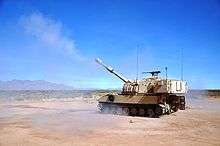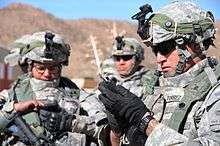Brigade Modernization Command

The U.S. Army Joint Modernization Command,[1] or JMC, was formerly the Brigade Modernization Command (BMC). The BMC was previously the Future Force Integration Directorate (FFID). It is subordinate to The U.S. Army's Training and Doctrine Command (TRADOC) and is part of the Army Capabilities Integration Center (ARCIC). The change reflects the Army’s commitment to its Incremental Brigade Modernization strategy and its effort to make BMC and the 2nd Brigade, 1st Armored Division the centerpiece of integrated network evaluations at Fort Bliss and White Sands Missile Range.
JMC conducts the integration and evaluations of the Army's network, capability packages and other capabilities to provide Doctrine, Organization, Training, Materiel, Leadership and Education, Personnel and Facilities recommendations to the Army. JMC gets capability solutions into the hands of soldiers faster than traditional channels by utilizing support from combat, training, and material developers and engineers early on in the development lifecycle.
JMC's commanding general is Brig. Gen. Johnny K. Davis, who took command on June 14, 2018,[2] succeeding BG Joel K. Tyler.[3]
Mission
"JMC plans, prepares and executes Joint Warfighting Assessments (JWAs) and other concept and capability assessments (CCAs), provides objective analysis and feasible recommendations to enhance Joint/Multi-National Interoperability (JMNI) and inform Army Modernization decisions. On order, conducts directed assessments in support of Cross Functional Teams."[4]
History


The U.S. Army Joint Modernization Command (JMC), previously the Brigade Modernization Command (BMC) was initially founded as the Future Force Integration Directorate (FFID) at Fort Bliss, Texas, based on an Army Chief of Staff directive to Training and Doctrine Command, dated December 20, 2005 to establish an on-site integration organization to facilitate development, testing and evaluation of the Future Combat Systems. FFID was organized as a directorate of the Army Capabilities Integration Center, a subordinate unit of TRADOC.
The organization's initial mission was to synchronize delivery, preparation and evaluation of all FCS-related products, which included complementary systems; development of doctrine, organization and training and leadership products which were synchronized with the FCS program manager, materiel developments and to exercise direct authority over the Army Evaluation Task Force, a unit of Soldiers that would test and evaluate the equipment.
The first FFID operations began at Fort Bliss on June 15, 2006. In December 2006, FFID was officially designated to exercise direct authority over the AETF. The AETF was officially activated on December 16, 2006 as the 5th Brigade Combat Team, 1st Armored Division, AETF.
In March 2007, ARCIC approved additional personnel for a general officer staff organization, which replicated a division headquarters. Brig. Gen. James L. Terry, FFID's first director, was welcomed in a formal ceremony on April 6, 2007. The establishment phase was scheduled to continue through June 2007.
In August 2007, the FFID mission was modified to integrate modernization efforts in support of Army transformation in order to provide FCS-enabled modular brigades beginning Fiscal Year 2011 and an FCS Brigade Combat Team at full operational capability in 2017 to joint force commanders. On October 1, 2007, FFID attained initial operational capability and assumed responsibility of FCS from the Unit of Action Maneuver Battle Laboratory based at Fort Knox, Ky.
During its short history, the organization conducted numerous training and testing events, as well as demonstrations of FCS capabilities for visits by senior Department of Defense and Army leadership, congressional leaders and staffers, business executives and national and local news media representatives. Distinguished visitors included the Secretary of Defense, Chief of Staff of the Army, Chairman of the House Armed Services Committee and other notable politicians and congressional staff delegations.
In April 2009, after the Secretary of Defense terminated the FCS program, FFID assumed responsibility for integrating BCT modernization for the Army. This included accelerated delivery of promising capabilities to the operating force. These "Spin Out" systems were bundled into "capability packages", which would be evaluated and delivered incrementally in two year periods.
In late 2010, the Army Vice Chief of Staff directed that FFID, along with Fort Bliss and White Sands Missile Range, become the Army's center for network integration. Since this would require a full Brigade Combat Team to load and test the network the Chief of Staff of the Army directed that the 2nd Brigade, 1st Armored Division take over the AETF mission from the 5th Brigade which would be deactivated in March 2011.
On February 7, 2011, the CSA directed that FFID be re-designated the Brigade Modernization Command with a mission to conduct physical integration and evaluations of the Army's network, capability packages and other capabilities in order to provide doctrine, organization, training, materiel, leadership, education, personnel and facility recommendations to the Army.
Today, BMC is focused on integrating test and evaluation events, including the Integrated Network Baseline Evaluation. The 2/1 AD conducts training and certification events to ensure individual and unit-level proficiency. While the network is central to Army brigade modernization efforts, 2/1 AD soldiers provide critical feedback that allows the U.S. Army to make decisions on which capabilities to acquire.
Network Integration Evaluation

The Network Integration Evaluation is a series of semi-annual evaluations designed to establish a Network Baseline and then rapidly build and mature the Army’s tactical Network.
During the Network Integration Evaluation scheduled for June 6, 2011 through July 15, 2011 at White Sands Missile Range, BMC, ATEC, and PEO-I will assess network and non-network capabilities, including Theater Provided Equipment, and developing and emerging network capabilities, and determine the implications of these capabilities across DOTMLPF. Success will be based on what can be learned when the capabilities are put in the hands of Soldiers in the field.
The Network Integration Evaluation will provide a means to evaluate relevant capabilities in parallel and make incremental improvements based upon a disciplined and professional feedback cycle. The effort will facilitate rapid evaluation of commercial and government network solutions to establish a Network Baseline and then rapidly build from it.
In addition to programs of record under test this June and July, a number of developing and emerging capabilities will be evaluated. The NIE events will help the Army achieve an agile process to optimize the BCT network. The 2012 Integrated Network Test will be the capstone event that solidifies the 2013-2014 Network Capability Set.
NIE, 2011 through 2017 TRADOC CG on NIE 16.1 NIE 16.1 /AWA proof of concept NIE 16.2 NIE 17.1 Force 2025
NIE 17.2, July 5th to 30th 2017, now involves the first rotational unit, 1,900 soldiers of the 2nd Brigade Combat Team, 101st Airborne Division, from Fort Campbell, Kentucky. Because 2/101 has just returned from a deployment, their feedback on new equipment for mission command and electronic warfare are as seen from the perspective of deployed or deploying BCTs.[5] [6]
The last NIE, 18.2, is to be in November of 2018. It will be replaced by JWA 19, a Joint Warfighting Assessment, to be held at Joint Base Lewis-McChord.[7] [8] For NIE 18.2, 3rd Brigade Combat Team, 82nd Airborne Division evaluates three systems under test:
- Mission Command Information System, which is part of the
- Command Post Computing Environment (CP CE); and the
- Mounted Mission Command System, part of the Mounted Computing Environment.
These systems will be stressed by a heavily contested cyber and electronic warfare environment. [9]
Army Warfighting Assessment
An Army Warfighting Assessment (AWA) is held to assess the capabilities of the Army to meet Army Warfighting Challenges (AWFCs) in a relevant operating environment. The capabilities are defined at the levels of the Secretary of the Army and the Chief of Staff of the Army. There are currently 20 challenges for the Army to meet.[10]
The first Joint Warfighting Assessment JWA 18.1, was held in Europe in the spring of 2018.[11][12]
A robotic complex breach concept (RCBC) was demonstrated for a multi-national (US - UK planning for training in Germany's Grafenwoehr Training Center) battalion operating at the joint level (Marines - Army - Navy) within a Corps echelon, meaning that robotic punch-through an obstacle which would stop a tank, across a minefield, with simulated chemical warfare, was demonstrated for units scalable to Corps level (multiple divisions of multiple brigades of multiple armored battalions).[13][14]
Joint Warfighting Assessment JWA 19 rotates to Joint Base Lewis-McChord in 2019,[8] to assess INDOPACOM's multi-domain task force operation.
Joint Warfighting Assessment JWA 20 rotates back to EUCOM in 2020, as presently planned (2018).
2nd Brigade, 1st Armored Division

In 2010, the U.S. Army attached 2nd Brigade, 1st Armored Division to the BMC, assigning it the evaluation mission previously held by the 5th Brigade, 1st Armored Division, AETF. The 2/1 AD has been given the mission of validating the operational relevancy of solutions and developing doctrine prior to fielding to deploying forces. It is an HBCT tasked organized that is equipped to replicate heavy, light and Stryker formations. 2/1 AD evaluates all network capability solution candidates and other Army Modernization capability candidates in a full spectrum operational environment at Fort Bliss, Texas and White Sands Missile Range. This unique Army mission supports adaptive evaluation of capability candidates, unit organizational design and operational concepts. The brigade provides immediate feedback that permits TRADOC to assess modernization concepts, identify implications, and enables the Army Test and Evaluation Command to assess the technical performance of materiel technologies.
2/1 AD Structure
- HHC 2nd BCT, 1st Armored Division
- 1st Battalion, 6th Infantry Regiment
- 1st Battalion, 35th Armor Regiment
- 1st Squadron, 1st Cavalry Regiment
- 4th Battalion, 27th Field Artillery Regiment
- 2nd Brigade Special Troops Battalion
- 47th Brigade Support Battalion
- Focus On: NIE on Army Brigade Combat Team Modernization website
In 2016, 2nd Brigade was added back to the Ready pool for deployment. Brigade Modernization Command thereupon received the materiel needed to run the NIE and AWA initiatives, which was divested by 2nd Brigade.[15]
References
- Brigade Modernization Command webpage, U.S. Army
- ARCIC Brigade Modernization Command webpage, U.S. Army
- Brigade Combat Team Modernization webpage, U.S. Army
- ↑ BMC redesignated JMC. New name better reflects evolving organizational mission
- ↑ (4 April 2018) General Officer Assignments: BG Johnny K. Davis
- ↑ (31 May 2018) BG Tyler relinquishes command of JMC
- ↑ JMC Mission
- ↑ 2ND BRIGADE COMBAT TEAM, 101ST AIRBORNE DIVISION ARRIVES FOR NIE 17.2
- ↑ (26 July 2017) Conditions perfect for NIE 17.2: 1st Bn., 26th Inf., 2nd BCT, 101st Abn. Div., conducts live fire
- ↑ (6 June 2018) Starting with an ending: As NIEs end, the JWA takes on new importance: JMC at Fort Bliss will finish last NIE here in November
- 1 2 Laven2 (3 October 2018) In preparation for JWA, Fort Bliss command asks the tough questions
- ↑ PEO C3T May 30 2018
- ↑ Force 2025 and Beyond Maneuvers and Army Warfighting Assessments accessdate=2016-09-08
- ↑ PROTOTYPES RAPIDLY DELIVER CYBER CAPABILITIES
- ↑ 18 May 2018 - JWA 18.1: A multinational think tank to improve network technology
- ↑ DFN:Robotics Complex Breach Concept Demonstration (B-Roll), GERMANY, 04.06.2018
- ↑ Fort Bliss' modernization command will deploy to Germany to run immense exercise
- ↑ Fort Bliss Bugle: "Divest, invest in property management" accessdate=2016-04-26